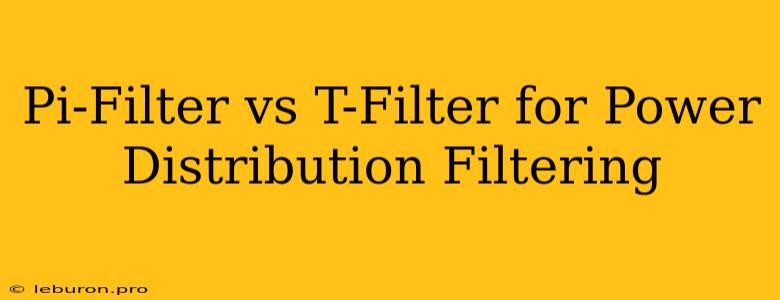Power distribution filtering is a crucial aspect of electronic circuit design, ensuring clean and stable power supply for sensitive components. This is achieved by employing various filter circuits, with Pi-filters and T-filters being two commonly used configurations. Both offer effective filtering capabilities, but their characteristics and applications differ significantly. This article delves into the intricacies of Pi-filter vs T-filter for power distribution filtering, examining their construction, advantages, disadvantages, and suitability for specific applications.
Understanding Pi-filters and T-filters
Pi-filter: A Classic Configuration
A Pi-filter, named after its resemblance to the Greek letter "π," consists of a series capacitor (C1), a shunt inductor (L1), and another series capacitor (C2). This configuration is commonly used as a low-pass filter, effectively attenuating frequencies above a specific cutoff frequency.
Diagram:
C1 L1 C2
|---------|---------|
| |---------|
| | |
----- ----- ----- -----
Input | | Output | |
----- ----- ----- -----
T-filter: A Shunt-Inductor Design
Conversely, a T-filter derives its name from its "T" shape. It comprises a shunt capacitor (C1), a series inductor (L1), and another shunt capacitor (C2). Similar to the Pi-filter, the T-filter acts as a low-pass filter, but its filtering characteristics differ due to the inductor placement.
Diagram:
C1
|---------|
| |
----- ----- -----
Input | | |
----- ----- -----
| L1
|---------|
| |
| C2
|---------|
----- ----- -----
| | Output |
----- ----- -----
Comparing Pi-filter and T-filter: Key Differences
1. Impedance Characteristics
Pi-filters exhibit a high input impedance and a low output impedance. This characteristic makes them suitable for applications where the source impedance is low, like a power supply. In contrast, T-filters possess a low input impedance and a high output impedance. Consequently, they are better suited for applications where the load impedance is high, such as sensitive electronic devices.
2. Frequency Response
Both Pi-filters and T-filters offer low-pass filtering capabilities, attenuating high frequencies while allowing low frequencies to pass through. However, the Pi-filter provides a steeper roll-off characteristic, meaning that it attenuates high frequencies more effectively than a T-filter. This is because the Pi-filter has two capacitors, contributing to a greater impedance change at higher frequencies.
3. Attenuation Characteristics
The Pi-filter demonstrates superior attenuation capabilities compared to the T-filter in the stopband (frequencies above the cutoff frequency). This advantage is attributed to the two capacitors in the Pi-filter acting as a voltage divider at higher frequencies.
4. Implementation Complexity
T-filters generally require fewer components than Pi-filters, which can simplify the filter construction. However, the reduced complexity can lead to a less effective filtering performance compared to a Pi-filter.
Choosing the Right Filter: Applications
The choice between a Pi-filter and a T-filter ultimately depends on the specific application requirements.
1. Power Supply Filtering
Pi-filters are the preferred choice for power supply filtering due to their high input impedance and superior attenuation characteristics. They effectively remove unwanted noise and transients, ensuring a clean and stable power supply.
2. Sensitive Circuit Protection
T-filters can be effective in protecting sensitive circuits from high-frequency noise and transients. Their low input impedance makes them less prone to loading down the source, while the high output impedance prevents noise from entering the sensitive load.
3. Audio Signal Filtering
Pi-filters are often employed in audio systems, particularly in crossovers, to separate different frequency ranges for speakers. Their steeper roll-off characteristic helps to achieve precise filtering for different audio bands.
Conclusion
In summary, Pi-filters and T-filters are both valuable tools for power distribution filtering, each offering distinct advantages and disadvantages. Pi-filters excel in power supply filtering and audio applications due to their superior attenuation characteristics, while T-filters provide suitable protection for sensitive circuits. Ultimately, selecting the appropriate filter type depends on the specific application requirements, including source impedance, load impedance, and the desired filtering performance. By carefully considering these factors, engineers can choose the most effective filter for their specific needs and ensure optimal power distribution for their electronic systems.
